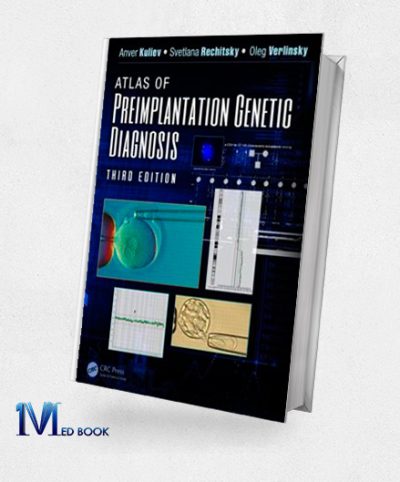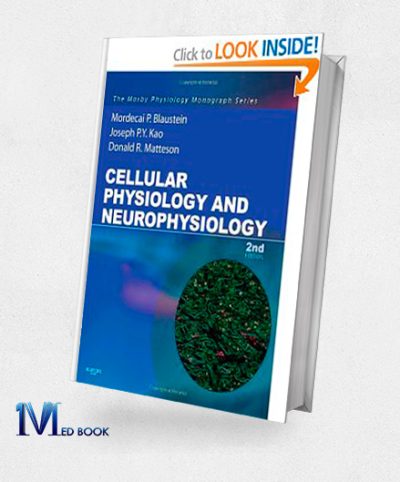Molecular Biology
Antioxidants and Stem Cells for Coronary Heart Disease
Original price was: $134.16.$22.00Current price is: $22.00.Atlas of Preimplantation Genetic Diagnosis Third Edition
Original price was: $221.30.$23.00Current price is: $23.00.Biased Signaling in Physiology Pharmacology and Therapeutics (ORIGINAL PDF from Publisher)
Original price was: $141.07.$27.70Current price is: $27.70.Biomedical Ethics A Canadian Focus, 3rd Edition (Original PDF from Publisher)
Original price was: $99.08.$30.00Current price is: $30.00.Bioquímica, biología molecular y genética (Board Review Series), 7th Edition (High Quality Image PDF)
Original price was: $64.00.$35.00Current price is: $35.00.BIOS Instant Notes in Molecular Biology (Original PDF from Publisher)
Original price was: $31.78.$21.00Current price is: $21.00.BRS Biochemistry Molecular Biology and Genetics (Board Review Series) 6th
Original price was: $44.57.$21.00Current price is: $21.00.Cancer Principles and Practice of Oncology Primer of the Molecular Biology of Cancer (Original PDF from Publisher)
Original price was: $86.01.$23.60Current price is: $23.60.Cell 2021 Full Archives (True PDF)
Original price was: $270.00.$45.00Current price is: $45.00.Cell and Tissue Based Molecular Pathology A Volume in the Foundations in Diagnostic Pathology Series (Original PDF from Publisher)
Original price was: $163.80.$29.00Current price is: $29.00.Cell Biology A Short Course 3rd Edition (Original PDF from Publisher)
Original price was: $67.30.$21.00Current price is: $21.00.Cellular Endocrinology in Health and Disease (ORIGINAL PDF from Publisher)
Original price was: $143.89.$27.90Current price is: $27.90.Cellular Physiology and Neurophysiology Mosby Physiology Monograph Series (with Student Consult Online Access) 2nd Edition (Mosbys Physiology Monograph)
Original price was: $38.65.$22.10Current price is: $22.10.Comparative Pathophysiology and Toxicology of Cyclooxygenases (Original PDF from Publisher)
Original price was: $135.00.$24.00Current price is: $24.00.Crash Course Cell Biology and Genetics 4th Edition (Original PDF from Publisher)
Original price was: $32.74.$21.90Current price is: $21.90.Current Advances in the Medical Application of Nanotechnology (Original PDF from Publisher)
Original price was: $49.00.$22.00Current price is: $22.00.Cytology Diagnostic Principles and Clinical Correlates 4th Edition (ORIGINAL PDF from Publisher)
Original price was: $176.64.$29.70Current price is: $29.70.Cytopathologic Diagnosis of Serous Fluids 1st Editoin (Original PDF from Publisher)
Original price was: $234.65.$32.90Current price is: $32.90.Cytopathology An Issue of Surgical Pathology Clinics
Original price was: $94.09.$25.10Current price is: $25.10.Diagnostic Cytopathology Essentials (Original PDF from Publisher)
Original price was: $156.36.$28.60Current price is: $28.60.Diagnostic Cytopathology Expert Consult Online and Print 3rd Edition (Original PDF from Publisher)
Original price was: $291.65.$36.00Current price is: $36.00.Effusion Cytology A Practical Guide to Cancer Diagnosis (Original PDF from Publisher)
Original price was: $94.05.$21.00Current price is: $21.00.Essential Cell Biology 4th Edition (Original PDF from Publisher)
Original price was: $143.45.$22.00Current price is: $22.00.Molecular Biology
introduction to Molecular Biology
Molecular biology stands as a cornerstone in the realm of life sciences, devoted to unraveling the intricate tapestry of biological processes at the molecular level. At its core, molecular biology delves into the study of the fundamental units of life, exploring the structure, function, and interactions of biomolecules that orchestrate the dance of life within living organisms.
The significance of molecular biology is profound, as it provides a molecular lens through which we can decipher the mysteries of life. By scrutinizing the blueprint encoded in biomolecules, such as DNA, RNA, proteins, and other cellular constituents, researchers gain unprecedented insights into the inner workings of cells and organisms.
One of the central pursuits of molecular biology is the exploration of the structure and function of biomolecules. Understanding the intricate architecture of DNA, the master molecule carrying genetic information, enables scientists to fathom the mechanisms underlying heredity and the transmission of traits from one generation to the next. Concurrently, the scrutiny of proteins, the molecular machines orchestrating myriad cellular processes, unveils the intricacies of biochemical pathways and cellular functions.
Molecular biology plays a pivotal role in advancing our comprehension of diseases, development, and evolution. By dissecting the molecular underpinnings of cellular processes, researchers gain valuable insights into the mechanisms that drive health and, conversely, the aberrations that lead to diseases. This knowledge forms the basis for groundbreaking medical interventions, personalized therapies, and the development of innovative treatments.
Moreover, molecular biology is instrumental in the fields of biotechnology and genetic engineering, where it serves as the bedrock for manipulating and optimizing cellular processes for diverse applications. From the production of pharmaceuticals to the engineering of crops with desirable traits, molecular biology empowers scientists to harness the potential of living organisms for the betterment of humanity.
In essence, molecular biology stands as a guiding light, illuminating the intricate details of life’s molecular choreography. Through its lens, we gain a deeper understanding of the mechanisms that govern living organisms, empowering us to unlock the secrets of health, disease, and the very essence of life itself.
Biomolecules Studied in Molecular Biology
Molecular biology, at its core, investigates a fascinating array of biomolecules that serve as the molecular architects of life. Four key classes of biomolecules—DNA, RNA, proteins, and lipids—stand as central players in the intricate dance of cellular processes, each contributing unique characteristics to the orchestra of life.
1. DNA (Deoxyribonucleic Acid):
– Structure: DNA is a double-stranded helical molecule, resembling a twisted ladder or double helix. It consists of nucleotide units, each comprising a phosphate group, a deoxyribose sugar, and one of four nitrogenous bases (adenine, thymine, cytosine, or guanine).
– Function: DNA harbors the genetic code, encoding instructions for the synthesis of proteins and the regulation of cellular activities. The complementarity of base pairing (A with T, and C with G) ensures faithful transmission of genetic information during cell division.
2. RNA (Ribonucleic Acid):
– Structure: RNA is a single-stranded molecule with a structure similar to DNA but with ribose sugar and the nitrogenous base uracil instead of thymine. There are various types of RNA, including messenger RNA (mRNA), transfer RNA (tRNA), and ribosomal RNA (rRNA).
– Function: mRNA carries genetic information from DNA to ribosomes for protein synthesis. tRNA aids in translating the genetic code by delivering amino acids to the ribosome. rRNA forms a crucial part of ribosomes, where protein synthesis occurs.
3. Proteins:
– Structure: Proteins are composed of amino acid chains folded into intricate three-dimensional structures. The primary structure is the sequence of amino acids, while the secondary, tertiary, and quaternary structures represent various levels of folding and interactions.
– Function: Proteins serve diverse roles, acting as enzymes that catalyze biochemical reactions, structural components providing cellular support, transporters of molecules across membranes, and signaling molecules that regulate cellular activities.
4. Lipids:
– Structure: Lipids encompass a diverse group of molecules, including fats, phospholipids, and steroids. Fats consist of glycerol and fatty acids, forming triglycerides. Phospholipids have hydrophilic heads and hydrophobic tails, constituting cell membranes. Steroids, like cholesterol, have a characteristic ring structure.
– Function: Lipids contribute to energy storage (as fats), form cellular membranes (as phospholipids), and serve as signaling molecules. Steroids play essential roles in hormone synthesis and maintaining membrane fluidity.
Emphasizing the fundamental roles of these biomolecules in cellular processes, molecular biology unravels the intricate dance of life at the molecular level, showcasing the beauty and complexity inherent in the building blocks of living organisms.
DNA Replication and Genetic Information
DNA Replication: Preserving the Blueprint of Life
1. Molecular Mechanisms of DNA Replication:
– Initiation: DNA replication begins at specific sites called origins of replication. Enzymes, including helicase, unwind the DNA double helix, creating replication forks.
– Elongation: DNA polymerase synthesizes a new strand complementary to each template strand. The leading strand is synthesized continuously, while the lagging strand is synthesized discontinuously in Okazaki fragments.
– Termination: Replication is completed as DNA polymerases finish synthesizing the entire DNA molecule. Special enzymes, like ligase, seal any gaps in the sugar-phosphate backbone.
2. The Fidelity of Replication:
– DNA replication is an incredibly accurate process due to the fidelity of DNA polymerases. These enzymes have proofreading mechanisms, known as 3′ to 5′ exonuclease activity, that allow them to correct errors during synthesis.
– Mismatch repair systems further enhance fidelity. Mismatched bases not corrected during replication are recognized and repaired post-replication.
3. Ensuring the Transmission of Genetic Material:
– Semiconservative Nature: DNA replication follows a semiconservative model, where each newly synthesized DNA molecule contains one parental strand and one newly synthesized strand.
– Telomeres: Eukaryotic chromosomes have telomeres at their ends, protecting them from deterioration during replication. Telomerase, an enzyme, helps maintain telomere length in certain cells.
4. Coordination and Regulation:
– Cell-Cycle Control: DNA replication is tightly regulated, and coordinated with the cell cycle. Checkpoints ensure that DNA is replicated accurately before the cell progresses to the next phase.
– Replication Origins: The precise selection and activation of replication origins are crucial for controlled DNA duplication.
5. Transmission to Subsequent Generations:
– Mitosis: In eukaryotic cells, DNA replication precedes cell division through mitosis. Each daughter cell receives an identical copy of the genetic material.
– Meiosis: In germ cells, a specialized type of cell division called meiosis results in the formation of gametes. Meiosis involves two rounds of division, reducing the chromosome number by half.
6. Challenges and Repair Mechanisms
– DNA replication faces challenges such as DNA damage, stalled replication forks, and other obstacles. Cells employ various repair mechanisms, including nucleotide excision repair and homologous recombination, to maintain genomic integrity.
Understanding the molecular intricacies of DNA replication is pivotal, not only for the preservation of genetic information within individual cells but also for ensuring the faithful transmission of this vital blueprint to subsequent generations. This process lies at the heart of cellular life, safeguarding the continuity of genetic instructions across the biological continuum.
Transcription and Translation in Molecular Biology
Transcription and Translation: Unveiling the Genetic Symphony
1. Transcription: Converting DNA into RNA:
– Initiation: Transcription begins as RNA polymerase binds to the DNA at a specific site called the promoter. The DNA double helix unwinds, exposing the template strand.
– Elongation: RNA polymerase moves along the template strand, synthesizing a complementary RNA molecule. The growing RNA chain is elongated in the 5′ to 3′ direction.
– Termination: Transcription concludes as RNA polymerase reaches a termination sequence. The RNA transcript is released, and the DNA helix reforms.
2. Types of RNA Produced:
– Messenger RNA (mRNA): Carries the genetic information from DNA to the ribosomes for protein synthesis.
– Transfer RNA (tRNA): Adapts mRNA’s genetic code to the amino acid sequence during protein synthesis.
– Ribosomal RNA (rRNA): Integral part of ribosomes, the cellular machinery for protein synthesis.
3. Translation: Crafting Proteins from RNA:
– Initiation: The small ribosomal subunit binds to the mRNA, and the initiator tRNA recognizes the start codon (AUG). The large ribosomal subunit joins, forming a functional ribosome.
– Elongation: Amino acids are added to the growing polypeptide chain as the ribosome moves along the mRNA. Each codon is recognized by a complementary tRNA carrying the corresponding amino acid.
– Termination: Translation concludes as a stop codon is encountered. Release factors facilitate the detachment of the completed polypeptide chain from the ribosome.
4. The Flow of Genetic Information:
– DNA to RNA (Transcription): Genetic information encoded in DNA is transcribed into RNA. The RNA molecule serves as a transient copy of specific genetic instructions.
– RNA to Proteins (Translation): The information carried by mRNA is translated into a sequence of amino acids, forming a polypeptide chain—the building block of proteins.
5. Codons and the Genetic Code:
– Codons: Triplets of nucleotides on mRNA, each coding for a specific amino acid or signaling the start/stop of translation.
– Genetic Code: The correspondence between codons and specific amino acids, ensuring the accurate translation of genetic information.
6. Regulation and Control:
– Gene Expression: Transcription and translation are intricately regulated, allowing cells to control when and how genes are expressed.
– Post-Transcriptional Modifications: RNA molecules undergo modifications, such as splicing and capping, before becoming functional.
7. Synthesizing the Cellular Symphony:
– Transcription and translation orchestrate the synthesis of proteins—the molecular machines and structural components essential for cellular functions.
– This intricate process exemplifies the remarkable precision with which cells execute the instructions embedded in their genetic code, ensuring the continuity of life.
Understanding the harmonious interplay between transcription and translation unveils the cellular symphony, where the melody of genetic information flows seamlessly from DNA to RNA and orchestrates the synthesis of proteins, the architects of cellular structure and function.
Regulation of Gene Expression
Regulation of Gene Expression: Orchestrating Cellular Symphony
1. Introduction to Gene Expression Regulation:
– Definition: Gene expression encompasses the processes by which information encoded in genes is used to synthesize functional gene products, primarily proteins.
– Importance: Precise regulation of gene expression is vital for maintaining cellular homeostasis, adapting to environmental changes, and orchestrating developmental processes.
- Key Players in Gene Expression Regulation:
– Transcription Factors: Proteins that bind to DNA regulatory regions, influencing the initiation or inhibition of transcription.
– Promoters and Enhancers: DNA sequences that control the initiation of transcription. Enhancers are regulatory elements that enhance promoter activity.
– Epigenetic Modifications: Chemical alterations to DNA or histone proteins that affect gene accessibility without changing the underlying DNA sequence.
3. Mechanisms of Gene Expression Regulation:
– Transcriptional Regulation: Controls the synthesis of RNA from DNA.
– Activators and Repressors: Transcription factors that enhance or inhibit gene transcription.
– RNA Polymerase Regulation: Control of the enzyme responsible for RNA synthesis.
– Post-Transcriptional Regulation: Modulates mRNA processing and stability.
– Splicing and Editing: Removal of introns or modification of RNA sequence.
– mRNA Degradation: Influences the lifespan of mRNA molecules.
– Translational Regulation: Governs the synthesis of proteins from mRNA.
– Initiation Factors: Control the binding of ribosomes to mRNA.
– RNA Interference (RNAi): Small RNA molecules regulate mRNA stability and translation.
– Epigenetic Regulation: Modifies gene accessibility without altering the DNA sequence.
– DNA Methylation: Addition of methyl groups to DNA, often associated with gene silencing.
– Histone Modification: Alterations to histone proteins, influencing chromatin structure and gene expression.
4. Cellular Functions and Gene Expression
– Cell Differentiation: Precise gene regulation directs cells to adopt specific fates during development.
– Environmental Responses: Cells adjust gene expression in response to external stimuli, adapting to changing conditions.
– Metabolic Regulation: Genes related to energy metabolism are regulated to match cellular needs.
5. Importance of Precise Gene Regulation:
– Disease and Disorders: Dysregulation of gene expression is implicated in various diseases, including cancer, metabolic disorders, and neurodegenerative conditions.
– Developmental Disorders: Errors in gene regulation can lead to developmental abnormalities.
6. Emerging Technologies in Gene Regulation:
– CRISPR-Cas9: Allows precise gene editing for therapeutic or research purposes.
– Synthetic Biology: Engineering biological systems to achieve specific functions, influencing gene expression.
7. Conclusion: Orchestrating Cellular Symphony with Precision:
– Gene expression regulation is akin to conducting a symphony, where timing, intensity, and harmony determine the cellular outcomes.
– A deeper understanding of gene regulation provides insights into disease mechanisms, therapeutic interventions, and the intricate dance of cellular life.
Molecular Biology Techniques
Advancing Molecular Biology: Techniques in Research
1. Introduction:
– Definition: Molecular biology techniques encompass a diverse array of methods designed to analyze and manipulate biological molecules at the molecular level.
– Significance: These techniques are fundamental to unraveling the complexities of cellular processes, studying genetic information, and advancing medical research.
2. Polymerase Chain Reaction (PCR):
– Principle: Amplifies a specific DNA segment through repeated cycles of denaturation, annealing, and extension.
– Applications:
– DNA Cloning: Producing multiple copies of a gene for further analysis.
– Genetic Testing: Detecting and analyzing genetic variations.
– Forensic Analysis: Amplifying DNA from crime scene samples.
3. DNA Sequencing:
– Principle: Determines the order of nucleotides in a DNA molecule.
– Applications:
– Genome Sequencing: Decoding entire genomes for understanding genetic information.
– Mutation Analysis: Identifying genetic variations associated with diseases.
– Phylogenetic Studies: Tracing evolutionary relationships.
4. CRISPR-Cas9 Gene Editing:
– Principle: Uses a guide RNA to target specific DNA sequences, enabling precise gene editing.
– Applications:
– Gene Knockout: Disabling a target gene to study its function.
– Gene Correction: Repairing mutated genes associated with diseases.
– Functional Genomics: Understanding gene function on a large scale.
5. Northern, Southern, and Western Blotting:
– Northern Blotting: Analyzes RNA expression.
– Southern Blotting: Identifies specific DNA sequences.
– Western Blotting: Detects and quantifies proteins.
– Applications: Assessing gene expression, validating DNA fragments, and studying protein levels.
6. Gel Electrophoresis:
– Principle: Separates molecules based on size and charge in an electric field.
– Applications:
– DNA Fragmentation Analysis: Sizing DNA fragments.
– Protein Separation: Analyzing protein profiles.
7. In situ Hybridization:
– Principle: Locates specific nucleic acid sequences within tissues.
– Applications:
– Gene Localization: Identifying gene expression patterns in tissues.
– Viral Detection: Locating viral genomes in infected cells.
8. Real-time PCR (qPCR):
– Principle: Quantifies the amount of amplified DNA during each PCR cycle.
– Applications:
– Gene Expression Analysis: Measuring changes in gene expression levels.
– Pathogen Detection: Identifying and quantifying infectious agents.
9. Mass Spectrometry:
– Principle: Analyzes molecules based on their mass and charge.
– Applications:
– Proteomics: Identifying and quantifying proteins.
– Metabolomics: Analyzing metabolites in biological samples.
10. Conclusion: Pushing Boundaries in Molecular Exploration
– Molecular biology techniques serve as powerful tools, pushing the boundaries of scientific exploration and opening new frontiers in understanding the molecular basis of life.
– Continuous advancements in techniques contribute to breakthroughs in diverse fields, from medicine to environmental science.
Molecular Biology in Disease Research
Molecular Biology in Disease Research: Unraveling the Molecular Tapestry
1. Introduction
– Scope of Molecular Biology: Molecular biology plays a pivotal role in disease research, providing insights into the intricate molecular mechanisms underlying various medical conditions.
2. Understanding the Molecular Basis of Diseases
– Genetic Mutations: Molecular techniques, such as DNA sequencing, uncover genetic mutations associated with hereditary diseases like cystic fibrosis and Huntington’s disease.
– Expression Profiling: Transcriptomics reveals aberrant gene expression patterns, aiding in the understanding of diseases like cancer and neurodegenerative disorders.
3. Identification of Biomarkers:
– Definition: Biomarkers are molecular indicators of normal or abnormal biological processes, providing crucial diagnostic and prognostic information.
– Application: Molecular techniques, including proteomics and genomics, help identify specific biomarkers for diseases like cardiovascular disorders and certain cancers.
4. Targeted Therapies Development
– Precision Medicine: Molecular biology enables the development of targeted therapies tailored to an individual’s molecular profile.
– Examples:
– Cancer Treatment: Targeting specific genetic mutations using drugs like imatinib.
– Monoclonal Antibodies: Therapies like trastuzumab for HER2-positive breast cancer.
5. Infectious Diseases and Molecular Diagnostics
– Rapid Detection: Techniques like PCR and nucleic acid amplification facilitate the rapid and accurate diagnosis of infectious diseases, including viral infections and antibiotic-resistant strains.
– Monitoring Pathogen Evolution: Molecular methods aid in tracking the evolution of pathogens, essential for vaccine development.
6. Neurological Disorders
– Genomic Studies: Molecular biology techniques identify genetic factors contributing to neurodegenerative disorders like Alzheimer’s and Parkinson’s diseases.
– Biomarker Discovery: Uncovering molecular biomarkers assists in early diagnosis and tracking disease progression.
7. Autoimmune Disorders
– Immune System Dysregulation: Molecular insights help unravel the molecular basis of autoimmune diseases, leading to the development of targeted immunotherapies.
– Identification of Autoantibodies: Molecular techniques assist in identifying specific autoantibodies associated with conditions like rheumatoid arthritis.
8. Cardiovascular Diseases
– Genetic Risk Factors: Molecular studies elucidate genetic predispositions to cardiovascular diseases, enabling risk assessment.
– Biomarker Panels: Molecular profiling contributes to the development of biomarker panels for early detection and personalized treatment.
9. Conclusion: Transformative Impact on Disease Management
– Molecular biology has transformed disease research, offering a molecular roadmap for understanding diseases, identifying biomarkers, and developing precise therapies.
– Ongoing advancements in molecular techniques promise continued breakthroughs, revolutionizing the landscape of disease diagnosis, treatment, and prevention.
Genomic and Proteomic Studies
Genomic and Proteomic Studies in Molecular Biology: Unraveling Cellular Mysteries
1. Introduction
– Genomics and Proteomics Defined: Genomic studies focus on the comprehensive analysis of genes and their interactions, while proteomic studies delve into the exploration of the entire set of proteins within a cell.
2. Genomic Studies (Genomics)
– Large-Scale Gene Analysis:
– High-Throughput Sequencing: Techniques like next-generation sequencing enable the rapid and cost-effective sequencing of entire genomes.
– Microarray Technology: Allows simultaneous analysis of the expression levels of thousands of genes.
– Functional Genomics:
– CRISPR-Cas9 Technology: Enables targeted gene editing, facilitating the study of gene functions.
– RNA Interference (RNAi): Suppresses gene expression, aiding in the determination of gene roles.
– Applications:
– Unraveling Genetic Variations: Genomic studies identify single nucleotide polymorphisms (SNPs) and structural variations, contributing to our understanding of genetic diversity.
– Comparative Genomics: Comparative analyses reveal evolutionary relationships between species and the functional significance of conserved genes.
3. Proteomic Studies (Proteomics)
– High-Throughput Protein Analysis:
– Mass Spectrometry: Identifies and quantifies proteins, offering insights into their structure and post-translational modifications.
– Two-Dimensional Gel Electrophoresis: Separates proteins based on charge and size for detailed analysis.
– Functional Proteomics:
– Protein-Protein Interactions: Techniques like yeast two-hybrid systems uncover interactions among proteins.
– Protein Folding and Structure: Investigates the three-dimensional structures of proteins.
– Applications:
– Disease Mechanisms: Proteomic studies identify biomarkers associated with diseases, aiding in early diagnosis and targeted therapies.
– Drug Discovery: Understanding protein functions facilitates the development of drugs targeting specific proteins or pathways.
4. Integrating Genomic and Proteomic Data
– Systems Biology Approach:
– Combines genomic and proteomic data to understand the holistic functioning of biological systems.
– Network Analysis: Reveals intricate connections between genes and proteins, providing insights into cellular processes.
– Personalized Medicine:
– Utilizes genomic and proteomic information for tailored treatment strategies based on an individual’s molecular profile.
– Pharmacogenomics: Predicts an individual’s response to specific drugs based on genetic variations.
5. Advancements and Future Directions
– Single-Cell Genomics and Proteomics: Emerging technologies focus on analyzing individual cells, offering unprecedented resolution.
– Functional Proteogenomics: Integrating genomic and proteomic data for a more comprehensive understanding of cellular functions.
6. Conclusion: Unveiling the Cellular Symphony
– Genomic and proteomic studies revolutionize our understanding of cellular functions, genetic variations, and disease mechanisms.
– As technologies advance, the integration of genomics and proteomics promises to uncover even more intricate details, paving the way for transformative breakthroughs in molecular biology.
Advancements in Molecular Biology
Recent Advancements in Molecular Biology: Shaping the Future of Scientific Exploration
1. Introduction: Unveiling Cutting-Edge Molecular Research
– Molecular biology, a dynamic field at the intersection of biology and technology, has witnessed remarkable advancements. Recent breakthroughs redefine our ability to explore the intricacies of living organisms.
2. Single-Cell Sequencing: Pioneering Precision at the Cellular Level
– Principle of Single-Cell Sequencing:
– Enables the genomic analysis of individual cells, providing unprecedented resolution.
– Applications:
– Cellular Heterogeneity: Reveals diverse gene expression profiles within a tissue, offering insights into cellular diversity.
– Cancer Research: Unravels the genetic heterogeneity of tumors, informing personalized cancer treatments.
– Future Implications:
– Holds promise for understanding developmental processes, neurobiology, and disease mechanisms with unparalleled precision.
3. CRISPR-Based Applications: Rewriting the Genetic Code
– CRISPR-Cas9 and Beyond:
– Genome Editing: CRISPR-Cas9 revolutionizes gene editing, allowing precise modifications to the DNA sequence.
– CRISPR Applications: CRISPRi (Interference) and CRISPRa (Activation) enable targeted gene regulation.
– Applications:
– Disease Modeling: Facilitates the creation of accurate disease models for research and drug development.
– Therapeutic Potential: Holds promise for treating genetic disorders by correcting disease-causing mutations.
– Future Prospects:
– Continued development of CRISPR-based technologies for advanced applications in synthetic biology and therapeutic interventions.
4. Omics Approaches: Decoding Complexity on a Global Scale
– Genomics, Transcriptomics, Proteomics, and Beyond:
– Integrative ‘omics’ approaches provide a comprehensive understanding of biological systems.
– Applications:
– Precision Medicine: Omics data inform personalized treatment strategies based on individual molecular profiles.
– Functional Insights: Unravel complex regulatory networks, pathways, and interactions within cells.
– Future Horizons:
– Advancements in multi-omics integration for a holistic view of cellular processes and responses.
5. Bioinformatics and Big Data Analytics: Navigating the Molecular Data Deluge
– Data Management Challenges:
– Massive datasets generated by omics technologies require sophisticated analytical tools.
– Applications:
– Pattern Recognition: Identifies trends, correlations, and novel associations in large-scale molecular datasets.
– Predictive Modeling: Harnesses data for predicting biological outcomes and understanding system dynamics.
– Future Challenges and Opportunities:
– Continued development of bioinformatics tools to extract meaningful insights from vast molecular datasets.
6. Conclusion: A Molecular Renaissance Unfolding
– Synergy of Technologies: The convergence of single-cell sequencing, CRISPR-based applications, omics approaches, and bioinformatics reshapes the landscape of molecular research.
– Paving the Way Forward: These advancements propel molecular biology into a new era of discovery, where the intricacies of life are unveiled with unprecedented precision and depth.
Conclusion
Molecular biology is an important field that plays a crucial role in understanding the complexities of life at a molecular level. It’s a combination of biology and technology that has transformed our understanding of genetics, medicine, and the mechanisms that govern biological systems. This field has brought significant advancements in science and continues to unravel the mysteries of the molecular world.
1. Decoding the Blueprint of Life
– Genetic Revelations: Molecular biology has been the torchbearer in deciphering the blueprint of life encoded in DNA. Through meticulous study and innovative technologies, scientists have unveiled the secrets of the genome, shedding light on the hereditary instructions that govern every living organism.
2. Precision in Medicine
– From Promise to Practice: The impact of molecular biology on medicine is profound. It has ushered in an era of precision medicine, where individualized treatments are tailored based on the unique molecular signatures of patients. Through omics approaches and CRISPR-based applications, the therapeutic landscape is evolving, offering new hope in the fight against genetic diseases.
3. Omics Revolution
– Holistic Understanding: Omics approaches have empowered researchers to take a panoramic view of cellular processes. Genomics, transcriptomics, proteomics, and more collaborate to provide a holistic understanding of biological systems. This integrative approach not only deepens our insights but also guides the development of targeted interventions.
4. Molecular Biology in Action
– Real-world Impact: From unraveling the intricacies of single-cell behavior to editing the genetic code with precision, molecular biology is not confined to laboratory benchwork. Its applications extend to disease diagnostics, therapeutic interventions, and the development of sustainable technologies, echoing its real-world impact.
5. A Dynamic Field of Exploration
– Continued Evolution: As we conclude this reflection, it is crucial to acknowledge that molecular biology is not static. It is a dynamic field continually evolving, propelled by technological innovations, interdisciplinary collaborations, and an unyielding spirit of exploration. Emerging technologies like single-cell sequencing and CRISPR-based applications are heralding a new era in molecular research.
6. Pivotal Role in Scientific Renaissance
– At the Nexus of Discovery: Molecular biology, with its pivotal role in unraveling life’s mysteries, stands at the nexus of a scientific renaissance. Its contributions reverberate across disciplines, shaping the trajectory of genetics, medicine, and our broader comprehension of biological systems.
Molecular biology has played a pivotal role in advancing scientific knowledge. From the discovery of the DNA double helix to the precision editing of the genome, molecular biology has achieved significant milestones, and its future looks promising. By continuing to unravel the molecular intricacies of life, molecular biology will pave the way for unprecedented discoveries and innovations.

























